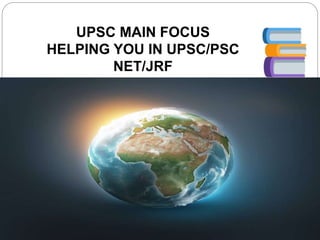
Classification of rocks
- 1. UPSC MAIN FOCUS HELPING YOU IN UPSC/PSC NET/JRF
- 2. CLASSIFICATION OF ROCKS 1. The hard, solid material that forms part of the surface of the earth. 2. A rock is any naturally occurring solid mass or aggregate of minerals. 3. The earth’s crust is made up of various types of rocks. 4. They differ from one another in texture, structure, colour, permeability, mode of occurrence and degree of resistance to denudation. 5. Rocks are classified into 3 major groups: Igneous, sedimentary and metamorphic acc to their origin and appearance.
- 4. IGNEOUS ROCKS 1. The igneous rocks (Ignis – in Latin means ‘Fire’) are formed when magma (at mantle) cools and solidifies. 2. As igneous rocks form out of magma and lava from the interior of the earth, they are known as primary rocks. 3. When magma in its upward movement cools and turns into solid form it is called igneous rock. 4. The process of cooling and solidification can happen in the earth’s crust or on the surface of earth.
- 5. TYPES OF IGNEOUS ROCK Basis of mineral composition: 1. Acid IR–- contain a high proportion of silica i.e. Granite. Less dense and lighter in colour than basic rocks. 2. Basic IR–- contain a high proportion of basic oxide i.e. Iron, aluminium or magnesium. Denser and darker in colour. Basis of origin: 1. Plutonic IR– also intrusive IR— formed at some depth in earth’s crust. E.g. granite, diorite and gabbro. Exposed at the surface by the processes of denudation and erosion. Large crystal. 2. Volcanic IR–- molten rocks poured out of volcanoes as lavas. Solidify rapidly on earth surface and small crystals. Also extrusive rocks and forms lava sheets and lava plateaus E.g. Deccan plateau in India and Columbia
- 7. SEDIMENTARY ROCKS 1. Word ‘sedimentary’ – Latin word ‘sedimentum’– means – ‘settling’ 2. SR formed from sediment accumulated over long time periods, usually under water– through compaction turns into rocks– ‘lithification’ . 3. Layer formation and are termed stratified rocks. 4. Sediments – brought by streams, glaciers, winds or even animals. 5. Strata (layers) present and also fossils – present. E.g. Sandstone, shale etc.
- 8. TYPES OF SEDIMENTARY ROCKS SRs may be classified under three major categories depending upon mode of formation: 1. Mechanically formed SRs— Formed by mechanical agents like running water, wind, ocean currents, ice, etc. Sediments– accumulation– cemented – rocks. E.g. sandstone. Other e.g. shale or mudstone. Sand and gravel may occur in uncemented form. 2. Organically formed SRs— Formed from the remains of living organisms– such as coral or shellfish, whose fleshy parts have been decomposed, leaving behind the hard shells– most common rocks formed in this way– calcareous type. E.g. Limestone and chalk.
- 9. CONTINUED… Carbonaceous rocks – also organically formed but from vegetative matter – swamps and forests – under high P & T– covert into compact masses of carbon. E.g. Peat, lignite or coal. 3. Chemically formed SRs— ∙ Such rocks are precipitated chemically from solutions of one kind or another. E.g. Rock salts– derived from strata which once formed the beds of seas or lakes. . Gypsum and calcium sulphate is obtained from the evaporation of salt lakes, such as Dead sea, have a very high salinity.
- 11. METAMORPHIC ROCKS Metamorphic– means ‘change of form’. Formed under the action of PVT changes. Metamorphism occurs -- when rocks are formed down to lower levels by tectonic processes or when molten magma rising through the crust comes in contact with the crustal rocks or the underlying rocks are subjected to great amounts of pressure by overlying rocks. Metamorphism is a process by which already consolidated rocks undergo recrystallisation and reorganisation of materials within original rocks. Dynamic Metamorphism– without any appreciable chemical changes – mechanical disruption and
- 12. CONTINUED... A. Thermal Metamorphism– materials of rocks chemically changed and recrystallise due to thermal metamorphism– contact M and regional M. B. Contact M – rocks come in contact with hot intruding magma and lava and rock materials recrystallise under high T. New materials form out of magma or lava are added to the rocks. C. Regional M– rocks undergo recrystallisation due to deformation caused by tectonic shearing together with high T or P or both.
- 13. ● Foliation or lineation-- an arrangement of minerals or grains in layers or lines in the process of metamorphism. ● Banding -- sometimes minerals or materials of different groups are arranged into alternating thin to thick layers appearing in light and dark shades. Such structure – banding and such rocks – banded rocks.
- 14. TYPES OF METAMORPHIC ROCKS Depending upon original rocks classified into two major groups... Some example of metamorphism: Clay --- slate Limestone --- marble Sandstone --- quartzite Foliated e.g. Schist, Slate, Gneiss Non- foliated e.g. Quartzite, Marble
- 16. . Discovered by– James Hutton . Igneous rocks are primary rocks and other rocks ( sedimentary and metamorphic ) form from these primary rocks..
- 17. STAY HOME, STAY SAFE THANK YOU ...